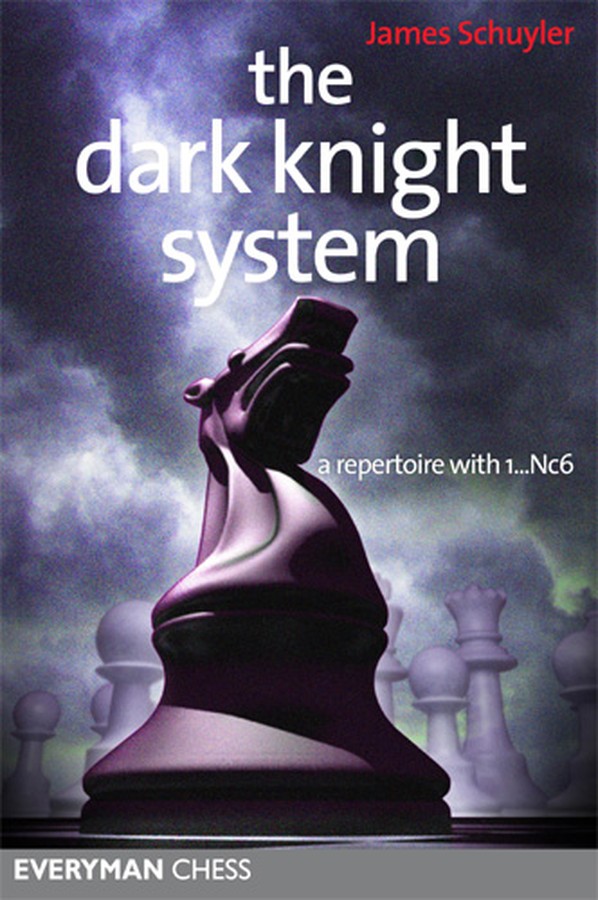| Nivå | B-D |
| Utgivelsesdato | Mars 2013 |
| Forfatter | |
| Pris | 250 NOK |
The Dark Knight System
A repertoire with 1.. Nc6En første moderne bok om systemer med 1... Sc6 som universalvåpen, der svart senere tilstreber e5 og spill på svarte felter, mye i motsetning til Wisnewskis bok "Play 1... Nc6". Denne nye boka har også trekkomkastning til flere åpninger, blant annet Pirc med Sc6, eller til og med Skotsk etter 1 e4 Sc6 2 d4 e5 3 Sf3.
Boka er moderne også i betydningen at forfatteren - en amerikansk FIDE-mester - har gjort et seriøst arbeid med Houdini 3, eller "Mr. H" som han noen ganger kaller analysepartneren. Gjennom arbeid med Houdini 3 forkaster han i denne boka noen tidlige valg som både han selv og andre har praktisert, og med suksess, opp gjennom årene, fordi hvitspillerne ikke har valgt riktig fortsettelse.
Størstedelen av boka er en klassisk teoretisk oppstilling, men repertoarmessig sett fra svarts side. Den siste tredjedelen består av 100 illustrerende og passe kommenterte partier opp mot teorien.
9 av de 100 illustrerende partiene er spilt av den dessverre avdøde fremragende stormesteren Tony Miles i senere år av karrieren hans. For eksempel 1 e4 Sc6 2 d4 e5 3 dxe5 Sxe5 4 Sc3 Lc5 5 f4 Sc6 6 Sf3 d6 som i Fedorchuk - Miles, EM 2001 (0-1), eller 1 d4 Sc6 2 e4 e5 3 d5 Sce7 4 c4 Sg6 5 Le3 Lb4+ 6 Sd2 Sf6 7 f3 De7 8 g3 0-0 9Lh3 c6 som i Kaidanov - Miles, Palma 1989 (0-1), eller 1 d4 Sc6 2 e4 e5 5 d5 Sce7 4 Le3 f5 som i Campora - Miles, Sevilla 1993 (0-1).
Starten på forfatterens utmerkede innledning i boka:
1...Nc6 and the Kevitz System Why another repertoire book on 1... Nc6 - ? Didn’t one come out just a few years ago? As it turns out, the subject matter here is completely different, as are the types of positions reached. 1...Nc6 isn’t really an opening yet, but the starting point for many openings. This book generally concerns itself with Black’s plans for using 1...Nc6 to force ...e7-e5, as played by Tony Miles, for instance. This idea is properly known as the Kevitz System. (Wisnewski’s repertoire book on ...Nc6 was all about the Nimzowitsch and Chigorin Defences, in which Black plays 1...d5 or 2...d5.)
The Dark Knight System? For reasons I will lay out, I will be recommending a fianchetto of the king’s bishop if White resists the ...e7-e5 advance. These are in fact the most com- mon positions, and they have a much different feel from a typical Kevitz Sys- tem. Furthermore, I believe that the fianchetto is a substantial improvement over the commonly played moves, and therefore a new name is in order. Since it is a black knight venturing out from a dark square to initiate a strategy of dark-square control... need I go on?
Does the Dark Knight System work? It works wonderfully, and in two ways. Firstly, it can throw White on his own devices as early as move one! When forced to improvise, even titled players can play shockingly weak moves or expend their time and energy in the opening. Secondly, the opening is fully sound and playable against all calibre of opposition. Black is fundamentally okay so there will be no need to aban- don the repertoire just because your opponents are no longer surprised. Furthermore, this book is intended to leave you a step or two ahead of even very well-prepared opponents.
I would like to take the opportunity to say that, in general, the quality of play in Dark Knight variations has been low for both colours. In many common positions, as early as moves six, five, four, and three (!) the unquestionably best moves have been rarely or never played! To some extent this is under- standable in an “unorthodox” opening, particularly for White, who has more important things to worry about. It is less understandable for Black, who can hardly be surprised by his own opening. However, from Black’s standpoint, this is highly correctable – and what better opening to use than one in which there is a long history of incompetence by the opponent, even at the GM level? I suggest that Black’s practical results (which are by no means bad) can be substantially improved.
Who plays it? As far as I know, nobody plays the Dark Knight in exactly the fashion I will be recommending, but many strong players use large parts of the repertoire, and most of the bits and pieces have been tested in high-level encounters. In spite of the relative obscurity of the Kevitz System, it should be noted that it was one of Miles’s regular weapons against both 1 e4 and 1 d4, and IM Zvonimir Mestrovic plays it frequently – they each have hundreds of 1...Nc6 (with the idea of ...e7-e5) games to their credit. It has also seen use by GMs Bogoljubow, Mikenas, Short, Hoi, Lazic, Velimirovic, Benjamin, Gausel, Svidler, Huang Thong Tu, Hort, A.Sokolov, Sulskis, Godena, Izeta Txabarri, Gulko, Klinger, Rogers, Olafsson, Tolnai, Art.Minasian, Ubilava, Sadler, Anand, Dizdarevic, Gonzales, Speelman, Mohr, Bachmann, Zarnicki, Gelashvili, Leko, Johansen, Shkuro, Rohde, Karpatchev, Ermenkov, Bezgodov, and de facto GM Nikolaevsky – not to mention IMs Kjeldsen, Cvetkovic, Przewoznik, Vlassov, Danailov, Tarlev, Barle (frequently), Z.Nikolic, Vujadinovic, Wohl, Sommerbauer, Mascaro, Matikozian, O’Donnell, Eid, Ambrus, Kos, Bus, and presumably many others that I have missed. So, as we can see, not only are strong players willing to play these positions (and against other strong players) they do so over and over, in some cases without any expectation of surprising their opponents. This says a lot about the hidden consensus as to the merits of the opening among those in the know.
Coverage This is a repertoire book, but I am not adhering slavishly to the concept. Side- lines for Black are presented if they are useful or enlightening. One situation that sometimes comes up is that a main line, while objectively fine for Black, offers very few winning chances. In this case, I will try to offer an alter- native which makes it more practical to play for a win, normally with substan- tial additional risk (otherwise it would have been chosen as the main line). Transpositions to other openings are obviously frequent, but I will not abandon the reader just because we have reached a position that happens to be known by a different name. ...
| Innbundet? | Nei |
| Type | Bok |
| Språk | Engelsk |
| Antall sider | 224 |

